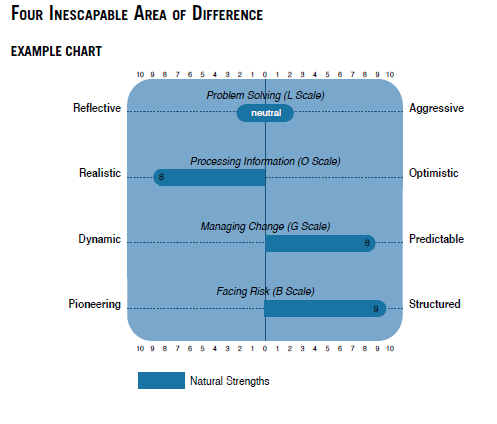Four Ways You Are Unique
Third in a series explaining how Certified Practitioners help you process profiles
Your Leading From Your Strengths Profiles presents four areas of strengths in which you are unique: solving problems, processing information, managing change, and facing risk. Each person operates within these four areas each day. They are inescapable.
A practitioner is trained to understand each of the four areas and the contrasting strengths represented in each.
 As you work through your profile report with a skilled practitioner, you will discover where your strengths lie on the scale in each of the four areas. Each strength has equal weight. You are wired to naturally approach and respond in predictable ways, which will vary in an intensity that is unique to you.
As you work through your profile report with a skilled practitioner, you will discover where your strengths lie on the scale in each of the four areas. Each strength has equal weight. You are wired to naturally approach and respond in predictable ways, which will vary in an intensity that is unique to you.
A skilled practitioner not only helps you discover your unique strengths mix in the four inescapable areas of differences, but also guides you through the process of striking a balance with those around you. Their strengths complete you. You complete their strengths, too.
Four Inescapable Areas of Differences
Area #1: Problem Solving
Your score in this area reflects how you most naturally go about solving problems – either from a reflective stance or an aggressive stance. Those on the reflective side of the scale will take a cautious, calculating approach. Those on the aggressive side of the scale are decisive, bold, and assertive when it comes to solving problems.
Practitioners are particularly adept at explaining how both approaches to problem solving have strong merits. Reflectives are more able to break down complex problems into different parts. Aggressives grasp opportunities and drive forward. Each simply leads from a different position.
Area #2: Processing Information
You possess one of two natural bents when it comes to processing information. Those whose natural approach is on the realistic side of the scale want facts. They need to validate information. On the other side of the spectrum, those with an optimistic approach are accepting and trusting of the information they receive. These people tend to communicate with emotion.
A good practitioner helps you to understand conflicts that may arise with others around you who process information differently from you. When a Realist asks validating questions, an Optimist may sense mistrust. When an Optimist presents ideas with to the Realist feelings instead of facts, communication can become closed. God has placed the Optimist in the relationship to see the vision and the Realist in the relationship to see the steps.
Area #3: Managing Change
How do you go about making transitions? A Dynamic operates at a fast pace. It is not unusual for a Dynamic to start many projects and be involved in multiple areas simultaneously. Meanwhile, a Predictable thrives in a slower pace, making logical plans for change while focusing on one project at a time.
A practitioner helps you to understand that both Dynamics and Predictables in your life contribute strengths. Dynamics are change agents – starters – while Predictables are finishers. When both types value the other, they can weather transitions together with strength.
Area #4: Facing Risk
Your natural bent may be to take fewer risks, choosing instead to follow rules and procedures. Your approach is structured. If a more pioneering approach is natural to you, then you tend to embrace risk and view rules and procedures as obstacles.
A practitioner helps you understand where conflict can arise between people who face risk differently. A Structured person see rules as a source of protection and tends to ask permission while a Pioneering person sees rules as simply guidelines and will tend to ask forgiveness.
A Practitioner Helps You Appreciate the Four Areas of Differences
“Our body would not be divided,” wrote Paul in 1 Corinthians 12:25 (NCT). “God wanted the different parts to care the same for each other.”
In other words, how you solve problems, process information, manage change, and face risk is different from everyone else around you. That is an inescapable fact.
Further, God does not intend for those differences to be a bone of contention in our relationships. His intent is quite the opposite. It is His desire that we acknowledge our differences and go a step further – care for those differences and value them in others.
Yet you may struggle to understand how to interact with those who are different from you in the four areas. Here is where a practitioner comes alongside you to provide insight. When you cannot see beyond the value in your approach, a practitioner points out how those differences are as God intended them: as strengths to complete you.
It is a subtle yet monumental shift … away from “you” and towards “us.” When you decide to value differences in these four inescapable areas, you stop looking at how you would solve the problem.
You start looking at how the problem itself should be solved, instead.
More Articles from The Practitioner Series
Ways a Certified Practitioner Can Help You, Part 1: Introduction
Ways a Certified Practitioner Can Help You, Part 2: Are You Independent or Interdependent?
Ways a Certified Practitioner Can Help You, Part 4: Getting the Most Out of Your Profile
